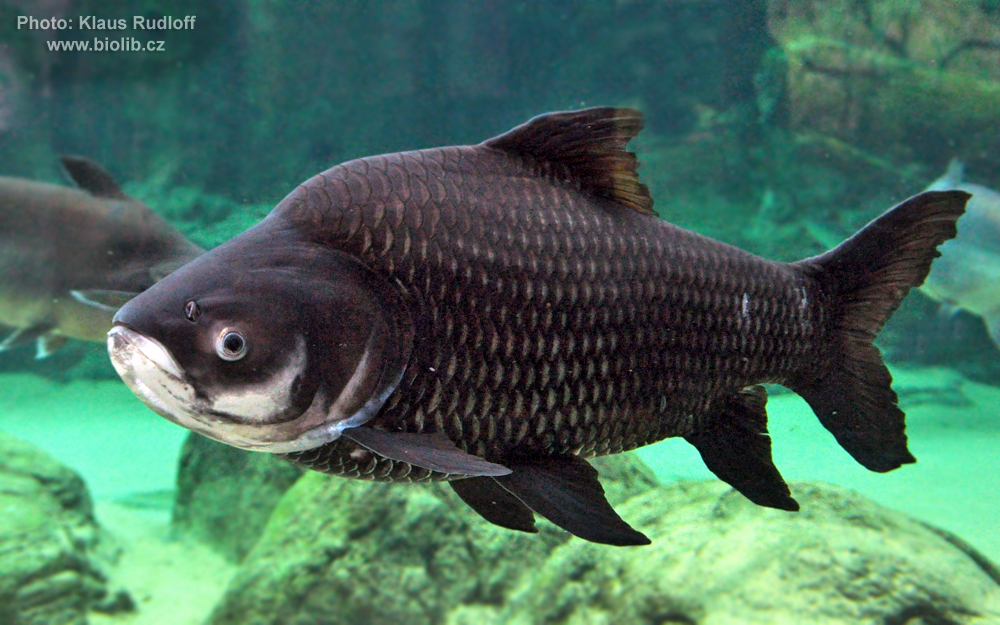Siamese giant carp
(Catlocarpio siamensis)

Classification
General data
The giant barb, Siamese giant carp, or simply Siamese carp (Catlocarpio siamensis), is the largest species of cyprinid in the world. These migratory fish are found only in the Mae Klong, Mekong, and Chao Phraya River basins in Indochina. Populations have declined drastically due to habitat loss and overfishing, and the giant barb is now considered critically endangered.
Distribution and habitat
Giant barbs are usually seen in large pools along the edges of large rivers, but seasonally enter smaller canals, floodplains, and flooded forests. Young barbs are usually found in smaller tributaries and swamps, but can acclimate to living in ponds, canals, and swamps. The fish generally live in pairs.
These are migratory fish, swimming to favorable areas for feeding and breeding in different parts of the year. These slow-moving fish subsist on algae, phytoplankton, and fruits of inundated terrestrial plants, rarely (if ever) feeding on active animals. In the lower Mekong basin, young giant barbs have been reported as occurring primarily in October.
Catlocarpio siamensis is now a rare fish species. However, the species is apparently encountered regularly at several stations ranging from Nong Khai, Thailand, and further north up to Chiang Saen, both on the Thai and the Lao sides of the Mekong River. It has also been recorded at stations in Nakhon Phanom and Ubon Ratchathani, Thailand. It is more common in Cambodia and Viet Nam, where it is encountered all the year at many stations.
Juveniles (2 to 6 cm in length) were reported by three locations in Thailand: Chiang Saen (Chiang Rai province), Tad Phanom (Nakhon Phanom province) and Khemmaratch, (Ubon Ratchathani province). In Cambodia, juveniles of the same size were reported in Sray Son Thor (Kompong Cham province) and Muk Kompul (Kandal province). In Viet Nam, juveniles have been recorded in Can Tho (Can Tho province) and Cao Lanh (Dong Thap province) in the Mekong River and in some canals.
Juveniles of 10-14 cm in length were also reported in the Songkhram River, Thailand, in November during the Phase I (trial) of the survey.
While the adults have a preference for large pools in the Mekong River, at least during part of the year, juveniles are mostly seen in floodplain habitats and small tributaries, from where they are sometimes collected and stocked in ponds. This is consistent with information given by Smith (1945), that - this is a fish of the large streams - but that - it breeds in Bung Borapet and other bungs (swamps) into which the floodwater of the river flows. However, large mature fish have not been observed in floodplain habitats and it is more likely that Catlocarpio spawns in certain habitats within the main river channel, from where eggs and/or larvae reach rearing habitats on the floodplain partly by passive drift.
Eggs are seen from January to August, but most fishermen reported finding eggs from May to July. This is consistent with the presence of juveniles, 2-4 cm in length, from July to November.
Physical characteristics
The head is rather large for the body, with no barbels.
The giant barb ranks among the largest freshwater fish in the world, and is probably the largest fish in the family Cyprinidae. It may reach 3 m (9.8 ft) (although this claimed maximum length needs confirmation) and weigh up to 300 kg (660 lb). Among the cyprinids, only the golden mahseer can reach a comparable length, but it is a relatively slender fish that weighs far less.
Few large giant barbs are caught today. For example, no individual weighing more than 150 kg (330 lb) has been caught in Cambodia since 1994. Today, the maximum length is about 1.8 m (6 ft).
This fish is a tetraploid, meaning it has four of each chromosome (as opposed to diploid, the normal number in animals).
Populations hypothesis
Above the Khone Falls, there are at least three populations of Catlocarpio siamensis. All three populations migrate into tributaries to spawn either in the tributary itself or within the associated floodplain.
One population occur in the upper part of the survey area and migrate from the Mekong mainstream to tributaries, e.g., in Chiang Rai province.
Further downstream, a population occurs around Nakhon Phanom province from where it migrates into tributaries, e.g., the Songkhram River.
Finally, there appears to be a population in and around Ubon Ratchathani province, which also migrates into tributaries to spawn.
Below the Khone Falls, there appears to be only one population. Spawning occurs mainly in the upper part of the stretch in the Mekong (i.e., upstream from Phnom Penh) and possibly also in the Sesan tributary system.
When the water begins to recede at the end of the flood season, the young-of-the-year and sub-adults migrate from flooded areas back into the main river channels and tributaries. During the dry season, Catlocarpio siamensis lives in deep pools associated with the main river channels.











